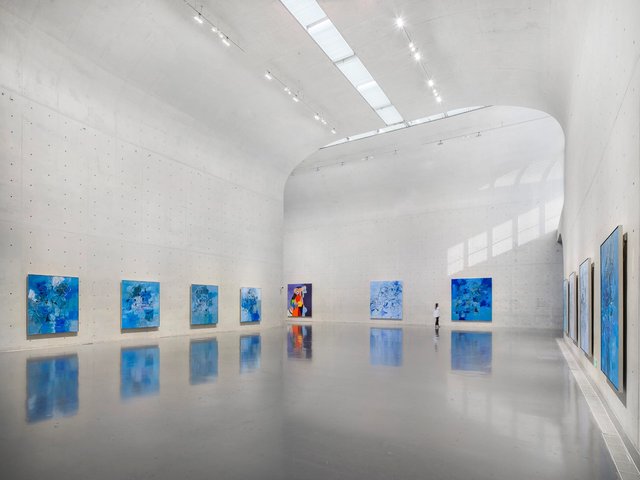A large group of international artists landed in Beijing in June bringing with them robots, light installations, interactive mobile plant pots, and various other works for display in “Synthetic Times”, at the National Art Museum of China (NAMOC), the first major survey of new media in the country.
The show, organised by the independent curator Zhang Ga, was staged with the collaboration of several international institutions including the Museum of Modern Art in New York, Tate in London, the Foundation for Art and Creative Technology, Liverpool, ZKM Center for Art and Media, Karlsruhe, and the Ars Electronica Center, Linz, among several others.
Despite the sweltering temperatures, most of the grandees of the Chinese art world attended the opening as did the bemused local media who explored the meandering exhibition and were only slightly intimidated by being chased by plant pots on wheels (courtesy of German artist Stefan Doepner).
“This is the coming of age show for NAMOC,” Zhang Ga, told The Art Newspaper.
The museum, now 50 years old, is establishing links with international institutions under the directorship of Fan Di’an, former vice president of the Central Academy of Art in Beijing, commissioner of the first Chinese Pavilion at the Venice Biennale in 2005, and one of the most prominent curators in China. He joined NAMOC in 2005 but has only been at the institution full time since this spring when artist Xu Bing was hired to replace him at the Central Academy of Art.
The international contributions for “Synthetic Times” included ten videos on loan from MoMA in New York. According to Barbara London, associate curator of the department of media at MoMA, curator Zhang Ga “asked us to lend an historical selection of single-channel videos as a complementary component of the show”. Ms London says MoMA decided to send works by Joan Jonas, Pipilotti Rist and Bill Viola, among others, because “NAMOC is one of the pre-eminent museums in China and its director, Fan Di’an, oversees a dynamic contemporary exhibition programme. We felt that it was important to collaborate.” She adds that Fan Di’an has accepted MoMA’s invitation to become a member of its International Council, which oversees a programme to establish relationships with museums around the world.
NAMOC staffers who spoke to The Art Newspaper at the opening were enthusiastic about the current exhibition programme and recently-forged international collaborations. To coincide with “Synthetic Times”, NAMOC also hosted an exhibition of works by Gerhard Richter on loan from German state museums in Dresden, Berlin and Munich.
“We only hope he [Fan Di’an] isn’t promoted upstairs into the Ministry of Culture, there are a lot rumours about it,” one staffer said.
Though “Synthetic Times” was beset slightly by technical issues, as NAMOC was not quite prepared to meet the technical requirements of many of the works, the show was positively received by local visitors, although some expressed reservations about the strong focus on technology and engineering. One of China’s leading new media artists, Zhang Peili, told attendees on the sidelines of a new media seminar that the show was too focused on technology, not art.
The exhibition was scheduled to last for just over three weeks; the organisers were unable to find another Chinese museum to host it after its run at NAMOC. “There were discussions with Shanghai, but it was too expensive,” Zhang Ga said.
“Zhang Ga spent only e2m to put on a show on this scale. He used every penny carefully,” said Sylvia Xu of Pro Helvetia, one of the exhibition sponsors.
Some artists wanted to donate their work to the museum, but the negotiations were scuppered by Chinese customs regulations. “The manifest for what leaves the country must be the same as what came in,” a NAMOC staffer explained.
Highlights of “Synthetic Times” included Swiss artist collective eToy’s virtual tomb of Timothy Leary which uses digital media and technology to create a digitized portrait of the late proponent of the psychedelic drug LSD; Jeffrey Huang and Muriel Waldvogel’s Newscocoons, a set of pulsating objects that track and display content found on the internet for certain keywords such as “body” and “alienation”; Xu Bing’s Book from the Ground which allows users to type sentences and have them instantly translated into a language of icons; and Stefan Doepner’s Living Kitchen, an installation in which kitchen appliances magically come to life.
In July NAMOC hosts the third edition of the Beijing Biennale, an international invitational exhibition, followed by a major retrospective devoted to Chinese artist Cai Guo-Qiang which was at the Guggenheim Museum in New York earlier this year (p27).
Originally appeared in The Art Newspaper as '“This is the coming of age show for the National Museum of China”'


